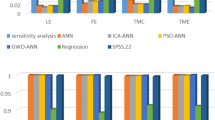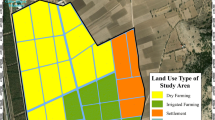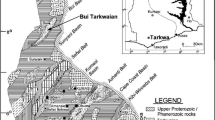Abstract
Background
Land leveling is one of the most important steps in soil preparation and cultivation. Although land leveling with machines require considerable amount of energy, it delivers a suitable surface slope with minimal deterioration of the soil and damage to plants and other organisms in the soil. Notwithstanding, researchers during recent years have tried to reduce fossil fuel consumption and its deleterious side effects. The aim of this work was to determine best linear model using artificial neural network (ANN), imperialist competitive algorithm and ANN and regression and adaptive neural fuzzy inference system (ANFIS) in order to predict the environmental indicators for land leveling.
Methods
New techniques such as; ANN, imperialist competitive algorithm and ANN and sensitivity analysis and regression and ANFIS that will lead to a noticeable improvement in the environment. In this research effects of various soil properties such as embankment volume, soil compressibility factor, specific gravity, moisture content, slope, sand percent, and soil swelling index in energy consumption were investigated. The study was consisted of 90 samples were collected from 3 different regions. The grid size was set 20 m in 20 m (20 × 20) from a farmland in Karaj province of Iran.
Results
According to the results of sensitivity analysis, only three parameters; density, soil compressibility factor and, embankment volume index had significant effect on fuel consumption. In comparison with ANN, all ICA-ANN models had higher accuracy in prediction according to their higher R2 value and lower RMSE value. Statistical factors of RMSE and R2 illustrate the superiority of ICA-ANN over other methods by values about 0.02 and 0.99, respectively.
Conclusion
Results extracted and statistical analysis was performed and RMSE as well as coefficient of determination, R2, of the models were determined as a criterion to compare selected models. According to the results, 10–8–3-1, 10–8–2-5-1, 10–5–8-10-1, and 10–6–4-1 MLP network structures were chosen as the best arrangements and were trained using Levenberg-Marquet as NTF. Integrating ANN and imperialist competitive algorithm (ICA-ANN) had better performance in prediction of output parameters in comparison with conventional methods such.







Similar content being viewed by others
Abbreviations
- ICAANN:
-
Integrating Artificial Neural Network and Imperialist competitive algorithm
- ANN:
-
Artificial Neural Network.
- LE:
-
environmental indicators: Labor Energy
- FE:
-
environmental indicators: Fuel energy
- TMC:
-
Total Machinery Cost
- TME:
-
environmental indicators: Total Machinery Energy
References
Khan F, Khan SU, Sarir MS, Khattak RA. Effect of land leveling on some physico-chemical properties of soil in district dir lower. Shar J Agr. 2007;23:108–14.
Kaveh A, Talatahari S. Optimum design of skeletal structures using imperialist competitive algorithm. Comput Struct. 2010;1(88):1220–9.
Cassel D, Wood M, Bunge RP, Classer L. Mitogenicity of brain axolemma membranes and soluble factors for dorsal rool ganglion schwann cells. J Cell Biochem. 1982;18:433–45.
Rallo R, Ferre-Gin J, Arenas A, Giralt F. Neural virtual sensor for the inferential prediction of product quality from process variables. Comput Chem Eng. 2002;26:1735–54.
Diamantopoulou MJ. Artificial neural networks as an alternative tool in pine bark volume estimation. Comput Electron Agric. 2005;2005(48):235–44.
Movagharnejad K, Nikzad M. Modeling of tomato drying using artificial neural network. Comput Electron Agric. 2007;59:78–85.
Nikoo MF, Ramezani M, Hadzima-Nyarko E, Nyarko K, Nikoo M. Flood-routing modeling with neural network optimized by social-based algorithm. Nat Hazards. 2016;82(1):1–24.
Rajabioun R, Atashpaz-Gargari E, Lucas C. Colonial competitive algorithm as a tool for nash equilibrium point achievement. Comput Sci Appl ICCSA Springer Berlin Heidelberg. 2008;2008(83):680–95.
Ahmadi MA, Soleimani R, Bahadori A. A computational intelligence scheme for prediction equilibrium water dew point of natural gas in TEG dehydration systems. Fuel. 2014;2014(137):145–54.
Ahmadi MA, Golshadi M. Neural network based swarm concept for prediction asphaltene precipitation due to natural depletion. J Pet Sci Eng. 2012;98:40–9.
Ahmadi MA, Shadizadeh SR. New approach for prediction of asphaltene precipitation due to natural depletion by using evolutionary algorithm concept. Fuel. 2012;102:716–23.
Brye KR, Slaton NA, Norman RJ. Soil physical and biological properties as affected by land leveling in a clayey Aquent. Soil Sci Soc Am J. 2006;70:631–42.
Ahmadi MA, Bahadori A, Shadizadeh SR. A rigorous model to predict the amount of dissolved calcium carbonate concentration throughout oil field brines: side effect of pressure and temperature. Fuel. 2015;139:154–9.
Jat ML, Gupta RK, Rodomiro RS. Diversifying the intensive cereal cropping systems of the Indo-Ganges through Horticulture. Chronica horticulturae. 2006;46:27–31.
McFarlane BL, Stump-Allen RCG, Watson DO. Public perceptions of natural disturbance in Canada’s national parks: the case of the mountain pine beetle (Dendroctonus ponderosa Hopkins). Biolo Con. 2006;130:340–8.
Abdechiri M, Faez K, Bahrami H. Adaptive Imperialist Competitive Algorithm (AICA), Cognitive Informatics (ICCI). 9th IEEE international conference. 2010. p. 940–945.
Fereydooni M, Mansoori B. Simulation depth of bridge pier scouring using artificial neural network and adaptive neuro–fuzzy inference system. Indian J Fundam Appl Life Sci. 2015;5:2091–5.
Shakibai AR, Koochekzadeh S. Modeling and predicting agricultural energy consumption in Iran. Am-Eurasian J Agr Environ Science. 2009;2009(5):308–12.
Toro J, Requena I, Zamorano M. Environmental impact assessment in Colombia: critical analysis and proposals for improvement. Environ Impact Assess. 2010;30(4):247–61.
Abdi B, Mozafari H, Ayob A, Kohandel R. Imperialist competitive algorithm and its application in optimization of laminated composite structures. Eur J ScI R. 2011;55(2):174–87.
Nikoo M, Ramezani F, Nyarko MH, Nyarko EK, Nikoo M. Flood-routing modeling with neural network optimized by social-based algorithm. Nat Hazards. 2016;82:1–24.
Ahmadi MA, Ahmadi MR, Shadizadeh SR. Evolving artificial neural network and imperialist competitive algorithm for prediction permeability of the reservoir. Appl Soft Comput. 2013;23(13):1085–98.
Lei K, Qiu Y, He Y. A new adaptive well-chosen inertia weight strategy to automatically harmonize global and local search ability in particle swarm optimization. Systems and Control in Aerospace and Astronautics, 2006. ISSCAA 2006. 1st International Symposium on, IEEE. 2006.
Moghaddam K, Far T. Laser land levelling as a strategy for environmental management: the case of Iran. Pollution. 2015;1(2):203–15.
Azadeh A, Ghaderi SF, Sohrabkhani S. Annual electricity consumption forecasting by neural network in high energy consuming industrial sectors. Energy Convers Manag. 2008;49:2272–8.
Tiryaki B. Predicting intact rock strength for mechanical excavation using multivariate statistics, artificial neural networks, and regression trees. Eng Geol. 2008;2008(99):51–60.
Talatahari S, Kavehand A, Sheikholeslami R. Chaotic imperialist competitive algorithm for optimum design of truss structures. Str Multidiscip O incl. 2012;46:355–67.
Ebrahimzadeh A, Addeh J, Rahmani Z. Control chart pattern recognition using K-MICA clustering and neural networks. ISA Trans. 2012;51:111–9.
Marto A, Hajihassani M, Armaghani D, Mohamad ED, Makhtar AM. A novel approach for blast-induced flyrock prediction based on imperialist competitive algorithm and artificial neural network. Hindawi Publishing Corp Scientific World J. 2014;15:1–11.
Taghavifar H, Mardani A, Taghavifar L. A hybridized artificial neural network and imperialist competitive algorithm optimization approach for prediction of soil compaction in soil bin facility. Measurement. 2014;46:2288–99.
Toro J, Requena I, Zambrano M. Environmental impact assessment in Colombia: critical analysis and proposals for improvement. Environ Impact Asses. 2010;2010(30):247–61.
Mohammadi A, Rafiee S, Keyhani A, Emam-Djomeh Z. Modelling of kiwifruit (cv. Hayward) slices drying using artificial neural network. 4th International conference on energy efficiency and agricultural engineering. Rousse, Bulgaria, 2009;1–3:397–404.
Okasha EM, Abdelraouf RE, Abode MAA. Effect of land leveling and water applied methods on yield and irrigation water use efficiency of maize (Zea mays L.) grown under clay soil conditions. World Appl Sci J. 2013;27:183–90.
Acknowledgments
We are thankful to our colleagues, the professors of Department of Surveying and Geometrics Engineering, Ph.D. students, and the Department of Surveying and Geometric Eng., Engineering Faculty, University of Tehran, Iran, who provided expertise that greatly assisted the research. The authors declare that there is no conflict of interests.
Funding
All parts of this research have been supported by University of Tehran.
Author information
Authors and Affiliations
Contributions
AI carried out all studies about the work and cultivated the data which were necessary to be analyzed. DM helped in statistical analysis. MF participated in land leveling studies results acquisition. A.N B helped in design and studying of artificial neural network. All authors read manuscript and approved it.
Corresponding author
Ethics declarations
Conflict of interest
The authors declare that they have no competing interests.
Consent for publication
Not applicable.
Ethics approval and consent to participate
Not applicable.
Rights and permissions
About this article
Cite this article
Alzoubi, I., Delavar, M.R., Mirzaei, F. et al. Prediction of environmental indicators in land leveling using artificial intelligence techniques. J Environ Health Sci Engineer 16, 65–80 (2018). https://doi.org/10.1007/s40201-018-0297-3
Received:
Accepted:
Published:
Issue Date:
DOI: https://doi.org/10.1007/s40201-018-0297-3




